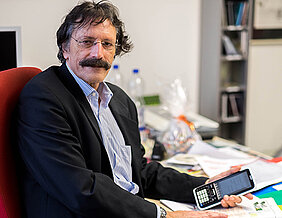Technical revolution in maths teaching
03/04/2016The new ClassPad Mathe calculator brings state-of-the-art technology to classrooms. Professor Hans-Georg Weigand from the University of Würzburg develops and evaluates such calculators in collaboration with Casio Europe GmbH.

For decades, Hans-Georg Weigand has observed how standard calculators have gradually evolved into compact, electronic all-rounders. Working closely with Casio Europe GmbH, the Würzburg didactics expert consistently enhances the handy calculators and thinks of ways to use them in class and features that have to be updated.
An assistant in various tasks
"Calculators have changed the way mathematics is taught," says Professor Weigand. How exactly this has happened is the focus of his research. Because unlike traditional models, modern calculators are equipped with all the functions needed in maths lesson and help pupils solve various tasks.
Today's calculators not only master basic arithmetic operations, they also compute equations, derivations or integrals. They are even capable of drawing tables or graphs in coordinate systems. So it is no wonder that some critics advise against overusing these gadgets, fearing this might be at the expense of traditional arithmetic skills.
What calculators do in class
Since 2005, Bavarian schools have run model tests with calculators. Weigand was there from the very beginning: Together with his assistants and students, the maths professor studied how using a calculator changes the way pupils do arithmetic operations.
Interviews conducted with pupils provided clear conclusions: "By using the calculator, pupils have not forgotten how to do a calculation in the traditional way," Weigand explains. Even though they did not fare better when it came to solving conventional tasks, they solved abstract questions and everyday problems more easily. They had better skills of putting into practice what maths is all about, namely to argue, solve problems independently and to work creatively with mathematical terms.
Pencil and paper will not disappear
Weigand and his students discuss how calculators have changed the way maths is taught in schools and will continue to do so. "Of course, a calculator will never replace the standard pencil and paper method," the professor emphasises.
But he believes that the traditional approach to teaching mathematics will change. And so Weigand's seminars familiarise future teachers with the modern calculators. Because one thing is for certain: To what extent calculators will be beneficial for pupils also depends on how reasonably they are used in class.
Latest calculators with eActivities
Casio has named its latest model ClassPad Mathe. The high-tech calculator has little in common with previous models. It features a modern touch pad and its design resembles a smartphone.
By offering so-called e-Activities, the ClassPad even enables real experiments and animations – sophisticated and dynamic work sheets, so to speak, that do not require learners to program complex drawings. Weigand and his assistant Ramona Behrens have greatly contributed to this development in partnership with Casio.
3D glasses for graphics?
The Würzburg researchers and Casio meet regularly to further refine the machines and adapt them to the new maths syllabus. They discuss with teachers, education ministries and other scientists in Germany how these devices can be constantly improved.
The maths teaching experts are also on the lookout for future trends, as rapidly changing technological developments will open up wholly new applications in future. 3D glasses to view graphics on a calculator? That is not a future dream for Weigand, but may soon be reality in classrooms.
Contact
Prof. Dr. Hans-Georg Weigand, Chair of Didactics of Mathematics of the University of Würzburg, Phone +49 931 31-85091, weigand@mathematik.uni-wuerzburg.de
Web link






